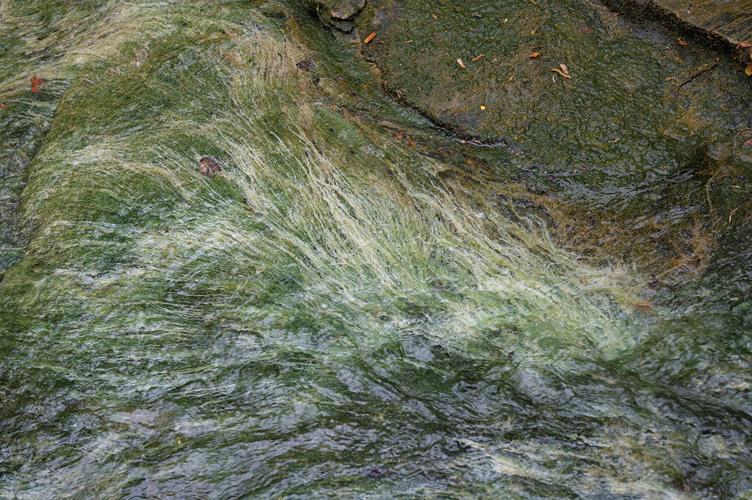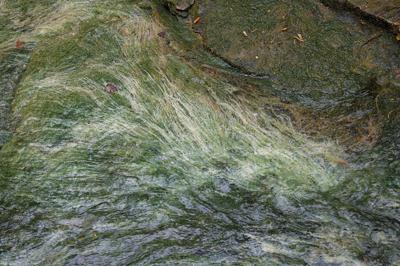Trace Creek is stringy like a mop, thick with algae and Sphaerotilus natans, a bacteria-loving growth known as “sewage fungus.” Coming down Liz Smith’s ridge in White Bluff, you can smell the creek before you see it. The odor falls somewhere between industrial cleaning solution and an over-chlorinated swimming pool.
According to Smith, it’s worse in the summer when the creek gets low and the air is hot. Last year, she began clearing a path to the creek for her grandkids when her brother, who had experience assessing water quality, raised concerns about the smell and a visible layer of gray-green scum.
“This is what people do here — we go out in the waterways,” says Smith, standing in her kitchen on a warm April day. “I want that pipe shut down. It’s a disaster.”
On the edge of Smith’s property, a white PVC pipe juts out from the bank, pumping treated sewage into Trace Creek. This is the discharge point for the White Bluff Wastewater Treatment Plant on Shady Oak Road, operated by the Dickson County Water Authority. Further upstream, before the discharge point, the scum and algae clear up, giving way to a rocky creek bed full of snails and camouflaged stoneflies.
“Their discharge permit prohibits discharge that creates visible scum, objectionable appearance, anything that would interfere with the recreational uses of this stream,” says George Nolan, an attorney at the Southern Environmental Law Center. “It appears to us that it’s a very clear pollution problem that needs to be addressed.” He brought the issue to the Tennessee Department of Environment and Conservation, which regulates water permits. They didn’t see a problem. In fact, TDEC had just approved their discharge permit.
“Frankly, we were shocked when TDEC took the position that there is no pollution, no permit violation and no problem,” says Nolan.
The water authority, state regulators, residents and environmental groups are now navigating a maze of appeals, hearings, rulings and corrective action. In one corner, the Water Authority of Dickson County argues that its three sewage plants — “water reclamation facilities” in industry jargon — have remained compliant with their permits even while expanding capacity to absorb explosive population growth. In the other, the Southern Environmental Law Center, on behalf of the Harpeth Conservancy, an environmental group, argues that visible pollution from WADC’s discharge point requires immediate action from TDEC regulators.

Trace Creek
Both sides have gotten mixed results from state regulators. After initially dismissing environmentalists’ concerns — officially filed as what’s known as a 118(a) complaint brought under the Tennessee Water Quality Control Act of 1977 — TDEC will have to defend its rationale in administrative court. Nolan, SELC and the Harpeth Conservancy appealed TDEC’s dismissal, elevating the matter to the Tennessee Board of Water Quality. In its legal filing, SELC argues that TDEC “is turning a blind eye towards visible pollution in Trace Creek.” A trial date is set for late October.
On April 4, TDEC indicated it will block WADC’s proposal for a new sewage treatment plant a few miles down Route 46 in Hickman County. The proposed plant would process up to 12 million gallons a day, several times bigger than WADC’s existing facilities, and discharge into Lick Creek, a popular fishing spot and tributary of the Duck River. The Lick and the Duck are vaunted as exceptional Tennessee waterways, an official recognition that confers additional protections against industry and development. Thousands of freshwater mussels purify the Duck, while Lick Creek is blessed with the coppercheek darter, a ray-finned fish the size of a large sardine.
The state argued that the facility’s danger to Lick Creek is more pressing than the need for additional sewage treatment. “WADC has not demonstrated that … degradation of Exceptional Tennessee Waters is necessary to accommodate important economic or social development … and has not demonstrated that less-degrading alternatives are not practicable,” reads its official statement, in part. The Tennessee Wildlife Federation and Friends of Lick Creek, a local advocacy group, celebrated the news. TDEC will host a public hearing in May before issuing a final ruling.
In its own letter, WADC argued that Dickson and Hickman counties are suffering economically. Expanded sewage capacity facilitates growth, allows for more homebuilding, and promotes industry. Waterways bear the burden. Population spillover from Nashville has driven demand for more infrastructure. Developers have pounced on cheaper land in Nashville’s “collar counties” like Dickson, Hickman, Cheatham, Sumner and Wilson. New clusters of homes mean solutions for how to get clean water in and sewage out.
“Builders, many from Nashville, come out to these rural communities that don’t have infrastructure for that kind of density,” says Dorie Bolze, who heads the Harpeth Conservancy. “They start to scream, ‘We don’t have enough money for a sewer plant.’ It’s hard for small towns. Growth needs water and sewer.”
More homes means more toilets; more flushing means more chlorine, nitrogen, PFOS, PFAS, phosphorus, E. coli and other chemical aspects of human life. Sewage discharge puts the state in the middle of growth and environmental protections, arbitrating an increasingly intense competition for habitat in Middle Tennessee between the residents of its houses and the residents of its rivers.
Exploring environmental activism, water quality, living alongside urban wildlife and more








